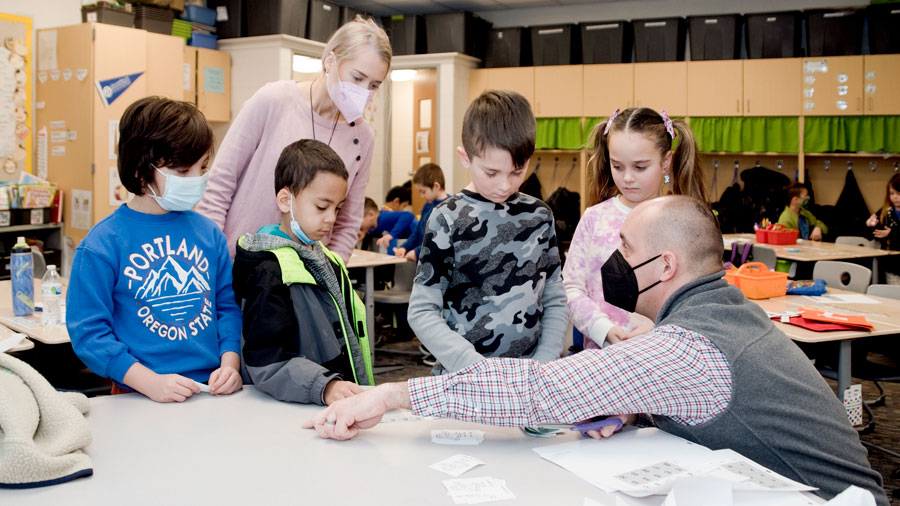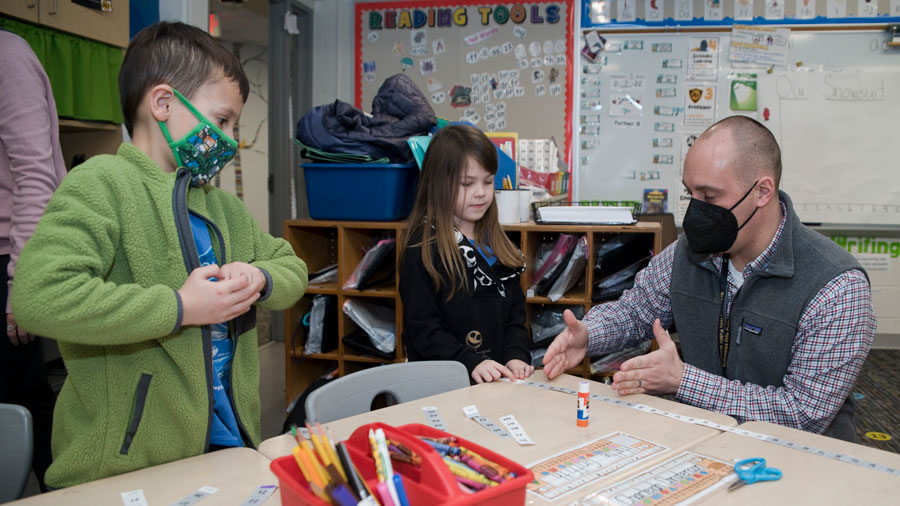Photos by Dianne Carroll Burdick
Multiple districts — In a first-grade classroom at Kenowa Hills’ Alpine Elementary School, teacher Becky Nicolette began a math lesson by pulling out a globe and asking her class to find Antarctica.
“What do you know about penguins?” she asked them.
“They slide on their bellies to go fast,” Isla Owen said.
“They’re efficient like mathematicians, just like us,” Nicolette responded.
The day’s math learning target included knowing how to organize, represent and interpret data and how to measure and express the length of an object as a whole number.
After Nicolette measured them against the wall, math coach Andrew Smith gave them each a paper snowsuit. Students colored their snowsuit green if they measured less than 40 inches, blue for 40-50 inches and red for greater than 50 inches.
“We get to be mathematicians when we use our number lines to measure, and scientists when we collect data on our pictograph,” Smith told the class.
To the room of first-graders, the exercise looked like cutting out vertical number lines to measure their heights and then determining which size snowsuit they would need to visit those penguins in Antarctica. It was exactly that, for sure. But for Nicolette it was also a fun way of teaching math with the support of a math coach – a position more districts are adopting to enhance teachers’ effectiveness and creativity.
Smith joins Nicolette’s class every Monday for “marvelous math Mondays with Mr. Smith.”
“We’re teaching them to see themselves as mathematicians,” Nicolette said. “I’m excited kids have a new way to learn math at Kenowa Hills.”

Helping Teachers Have Confidence
Smith first worked with Kenowa Hills during the 2018-19 school year, when he helped the district develop a new math curriculum. A committee of teachers and administrators met to identify which resource best suited the district’s needs and eventually decided on Bridges in Mathematics.
Since officially joining Kenowa Hills staff as math coach in August 2021, Smith’s role has continuously evolved to meet the needs of teachers and their students.
This spring, he was spending one to two days a week at the district’s three elementary schools, observing learning patterns and trends at each grade level.
“It’s never the same thing every day. Sometimes I run staff meetings, meet with teachers during their prep, or model lessons alongside teachers,” Smith said. “My main job is to support teachers and help them be more confident in teaching mathematics.”
Pandemic Funds Support New Positions
The idea of having a math coach is a relatively new one in Kent County schools, but it’s a role that is becoming increasingly more important as districts adopt new math curricula. It’s also a position that districts can more easily afford right now, thanks to pandemic-related Elementary and Secondary School Emergency Relief (ESSER) dollars.
“The pandemic, and everything that’s come with it, has really caused educators to pause and question some things, and I think math is becoming more pronounced,” said Marcus Deja, math consultant for Kent ISD. “It’s something that’s kind of taken a back seat to reading and writing, but right now everyone’s saying this could be a prime opportunity for us to focus on mathematics.
“The research has been around for over 30 years on what quality teaching and learning for math looks like — it just hasn’t made its way in (to the classroom) yet. So, a lot of districts are saying this is a need, and we’re certainly happy to provide that support for them.”
As a math consultant, Deja works to support both coaches and district staff as they consider or implement changes to math instruction. He also helps facilitate the MichMe professional learning network for math educators, building a communication system between a coach’s professional learning and the work that is actually happening in the classroom.
Cultivating Curiosity
With classroom instruction beginning to catch up with that research, Deja said math curriculum resources are shifting from a more traditional teaching method to something that’s more inquiry-based and collaboratively structured. The idea, he said, is to bring back a feeling of curiosity as students explore mathematics concepts.
“We present (students) with a problem or something that’s intriguing, and we ask students: What are you seeing? What questions do you have?” Deja said. “And that’s the hook for kids. Because no longer is the teacher saying, ‘Here’s what the answer is.’ They’re saying, ‘What do you recognize?’ And then we can say, ‘That’s mathematics! You’re problem-solving and recognizing patterns, and that’s mathematics.’”
The ideal math coach in this shifting environment, Deja said, is someone who “takes the research and the best practices into the classroom and … can focus on what evidence we have that practice change is happening.”
“I love that I can get together (with other coaches) and refine our practice, and then bring that experience back when I’m working with teachers.”
— Cedar Springs math champion Sammi TenHave
But a math coach also needs to understand a teacher’s current methodology and help guide them in those new and research-driven instruction shifts, he said.
“Teachers are the ones who connect with students, who build those relationships,” Deja said. “(A math coach) is trying to push into a new space of saying, ‘Math should be fun. Math should be a recognition of patterns.’ It’s not teacher-led; it needs to be open and dialogic and inquiry-based.
“The coaches are really trying to shift that mindset of what it means to be a quality math teacher, and they do that through modeling a lesson, and coaching conversations (after the lesson) with the teacher.”

Classrooms as Coaches’ Learning Labs
One tangible way Deja is helping support new math coaches in Kent County is by offering coaching labs, where Deja himself models the coaching process with a teacher and students in their classroom as the math coaches observe.
“It was so exciting to watch another coach, see how he does things, predict what he was going to do or how he would respond to a question, and then think about how I would have responded,” said Sammi TenHave, who just wrapped up her first year as Cedar Springs Public Schools’ first math champion.
TenHave was one of several area math coaches, including Kenowa Hills’ Andrew Smith, who participated in Deja’s first coaching lab. The lab took place in the classroom of Cedar Springs fifth-grade teacher Kara Smith, who was piloting a new math resource that the district was considering for next year.
With the coaches watching from the back of the room, Kara Smith led the math lesson with Deja co-teaching and coaching. The coaches took notes on what questions the kids asked; how Smith structured the lesson; and how Deja responded, guided and redirected conversations when necessary.
“We’re moving away from one path to many paths, like many genres of books, and it brings me joy.”
— Kenowa Hills math coach Andrew Smith
Afterward, the coaches got to ask Smith about her lesson and then had an extended conversation with Deja about what he did and why.
For TenHave, the common learning experience was invaluable, she said. While teachers can collaborate and bounce ideas off of each other, math coaches are often the only person filling that role in their district. The opportunity to come together and learn collaboratively serves every district in advancing and improving math instruction, she said.
“(The coaching lab) really just opened my mind up, getting all those different perspectives, because some of the things other people said, I never would have thought to do, or I’d never heard of,” TenHave said. “I love that I can get together (with other coaches) and refine our practice, and then bring that experience back when I’m working with teachers.”
Kenowa Hills’ coach Andrew Smith agreed.
“Learned leadership really matters,” he said. “There has to be an aligned vision and shared values and belief. Just because I am a coach doesn’t mean I’m the boss. I’m learning how important listening skills are and setting aside my own thinking and biases to be present and ask questions.”
Don’t Stick to the Script
Back in Becky Nicolette’s classroom at Alpine Elementary, the teacher said she appreciates having a different perspective in the classroom, which Smith often provides during the math lesson.
“(Smith) uses number models and presents information in a variety of ways to help my students feel successful,” she said. “He brought an awareness to not sticking to the script of teaching if it can help meet the needs of students.”
That idea of not sticking to a script, and embracing the uncertainty, is exactly what excites Smith in his role as a math coach.
“We’re shifting away from focusing on getting an answer and instead focusing on the path to finding the answer,” Smith said of the future of math instruction. “We’re moving away from one path to many paths, like many genres of books, and it brings me joy.”
Smith describes his ideal classroom as one where “math is about strategy harvesting, not about finding solutions.”
“Why do we read books? We read it for joy. A vision I have for math is very similar – you finish solving a problem and feel the joy of finding the strategy to get to the solution.”
To people who don’t like math or do not see themselves as “a math person,” Smith hopes to change their perception one math lesson at a time.
“We all do math when we’re at the store or telling time; math is all around us.”
SNN reporter Alexis Stark contributed to this story

















